THE TREE HEATHER POST
The tree heather, or giant heather, as it is called in some places, is a flowering plant native to the Mediterranean Basin and parts of East Africa.
It grows in sunny, open spaces as a large, robust shrub or a small tree.
In the coastal area called Palera, a couple of kilometers from the village of Liznjan and five or six kilometers from where I live, the dense growth of these plants forms an impenetrable maquis that provides shelter for many animals.

Today I'll try to show you the beauty, biodiversity, and uniqueness of an area densely covered with tree heather.
Here you can see the Cidnopus pilosus, a beetle from the Elateridae family, climbing the twigs situated low on the shrub.
The tree heather is an evergreen plant, its foliage doesn't change with the changing of the seasons.
However, that doesn't mean that the appearance of the habitat dominated by this plant remains uniformly green all year round.
A multitude of tiny, bell-like flowers covers the shrubs in springtime.
They look a bit like snow or frost when seen from a distance.
In this set of six photographs, you can see the Colletes succinctus, a bee from theColletidae family feeding on their nectar.
This mining bee, commonly known as the heather colletes, feeds mainly on flowers of plants from the Ericaceae family - which means heathers.

The scientific name of the tree heather is Erica arborea.
In this and the following shot ...
... you can see a butterfly resting on the twigs on the top of a pretty tall shrub.
The photographs were taken in summer when the flowers turned into fruits that looked like brown, dried-out flowers.
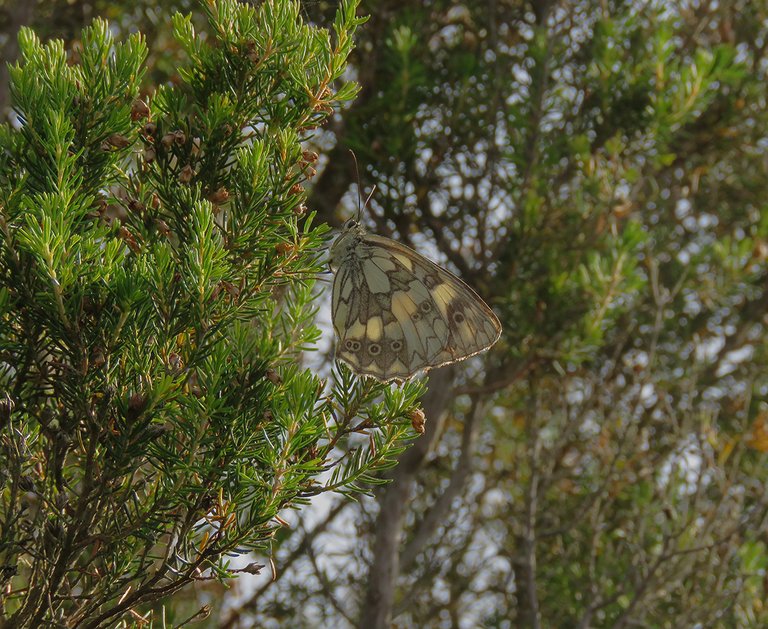
At the end of a long and usually hot summer day, after intensively searching for nectar on the coastal meadows of Palera ...

... the Melanargia galathea butterflies come to rest on the shrubs where most of them will spend the whole night.
These butterflies from the Satyrinae subfamily of the large and varied Nymphalidae family can be well-hidden and hard to notice on the tree heather.
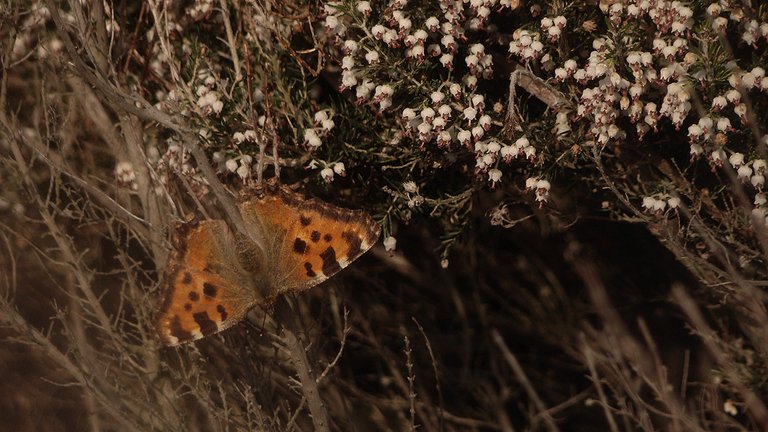
In spring, when the shrubs were still covered with fresh white flowers ...

... I photographed this butterfly from the Nymphalinae subfamily of the Nymphalidae family. The name of the species is Nymphalis polychloros.
In this set of four photographs, you can see the green stick insect walking among the flowers.
Here you can take a better, more up-close look at its head.
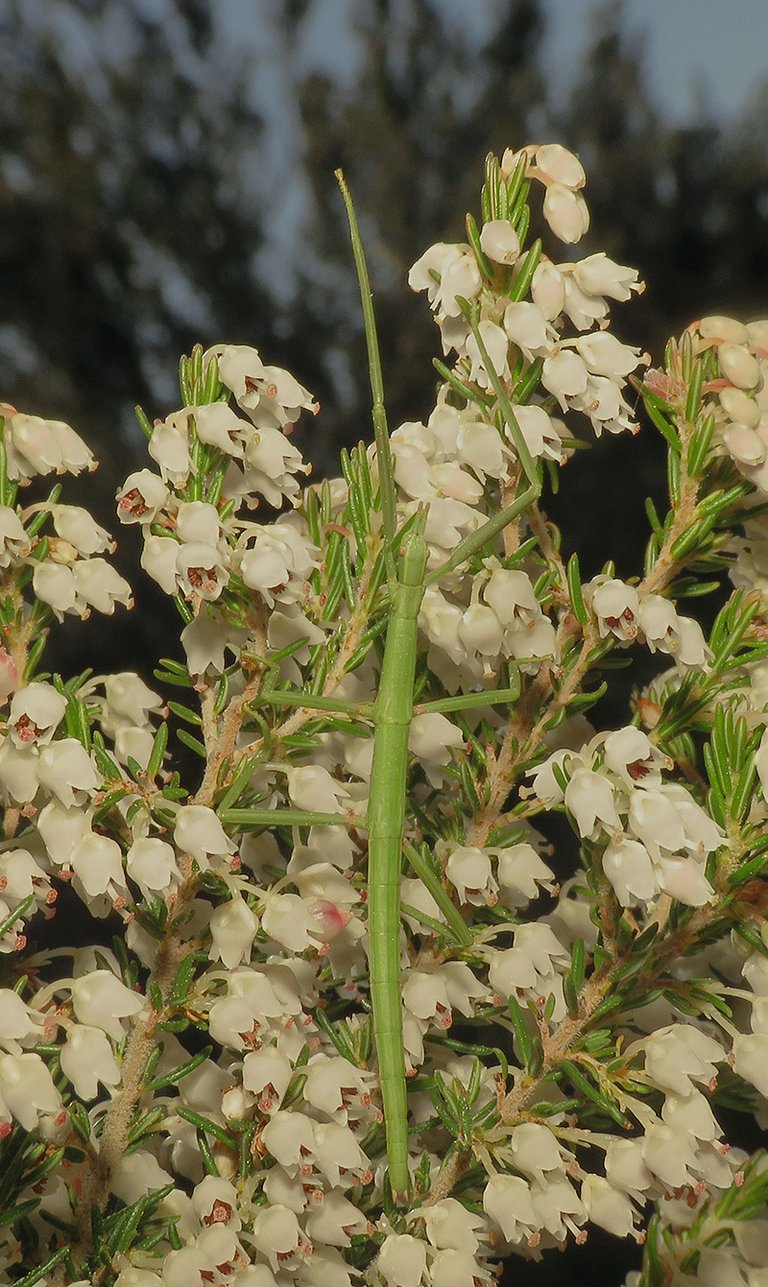
This species, the Bacillus rossius, commonly known as the Mediterranean stick insect, can be green, gray, or in a few shades of brown.
Here you can see a bee resting on the twigs.

In this case, I can't tell you the name of the species. To me, it resembles some bees from the Colletidae and Andrenidae family.
In this shot, the same bee was photographed in a slightly different pose, and from a slightly different angle, so the background is slightly different as well.
All that gives a slightly different feel to the picture.
In this photograph, you can see a small isolated Erica arborea shrub in the foreground and dense vegetal walls made of taller shrubs of the same kind in the background.

A very young Tettigonia viridissima nymph was resting on the lower twigs of the small shrub. The adult Tettigonia viridissima is a very big, robust bushcricket.

Here you can see a lovely trio of tree heather flower buds.
The buds and semi-opened flowers have a slight pinkish tinge.

Here you can see a caterpillar posing among the old flowers that are slowly turning into fruits.

in this shot, I came a bit closer, so you can take a better look at the caterpillar's red face.
It's a moth caterpillar. In its adult stage, this will be a diurnal moth from the Erebidae family.
The name of the species is Amata phegea. This caterpillar doesn't feed on tree heather but on a wide variety of common, widespread herbaceous plants like Plantago, Rumex, Galium, Taraxacum, and others.
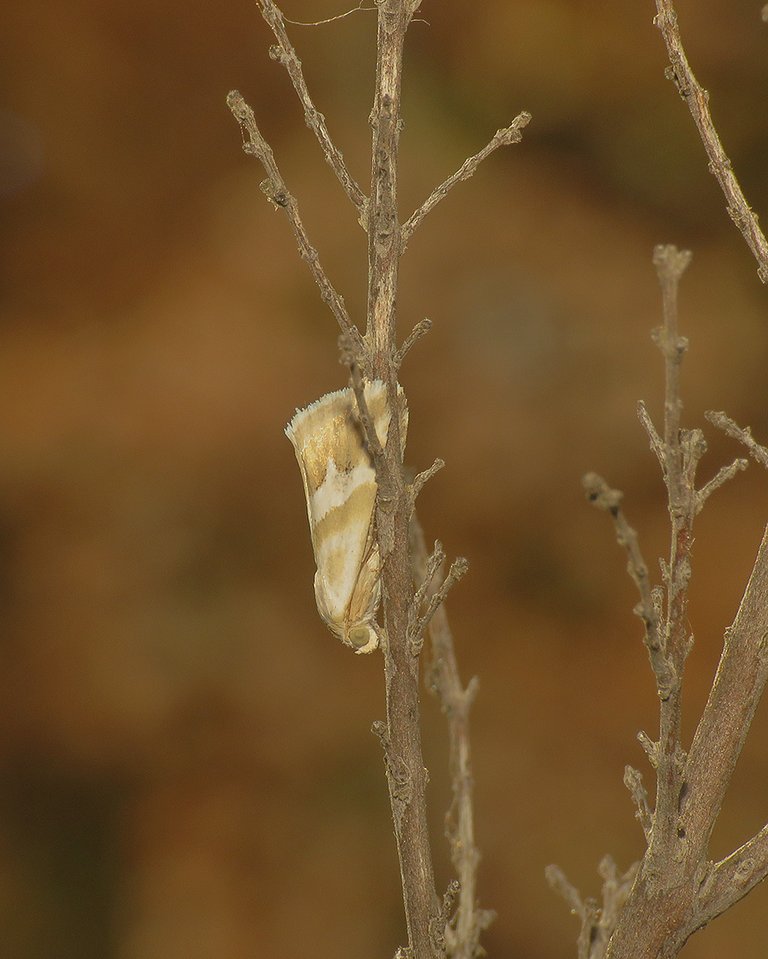
The moth shown resting on the dry, leafless twigs in this and the following three photographs also belongs to the Erebidae family.
Here you can see the same moth from two different angles.
The name of the species is Eublemma candidana.
In some places, isolated shrubs grow closer to the sea. I took this photograph on a windy stretch of coastline four or five kilometers north of Palera. The shrub shown here was shaped by the wind, it isn't small but is pretty low.
I photographed this moth on one of its barren branches. The name of the species is Agriphila inquinatella. It belongs to the Crambidae family.
A few minutes later, the moth flew away, but ...
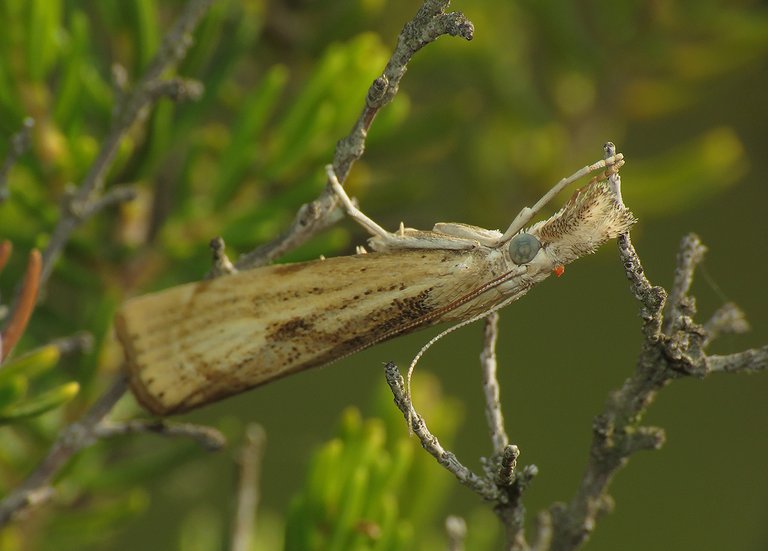
... but very soon landed on another branch of the same shrub. The moth is posing on another dry, leafless twig in this photograph, but the nearby twigs blurred in the background are green and vigorous.
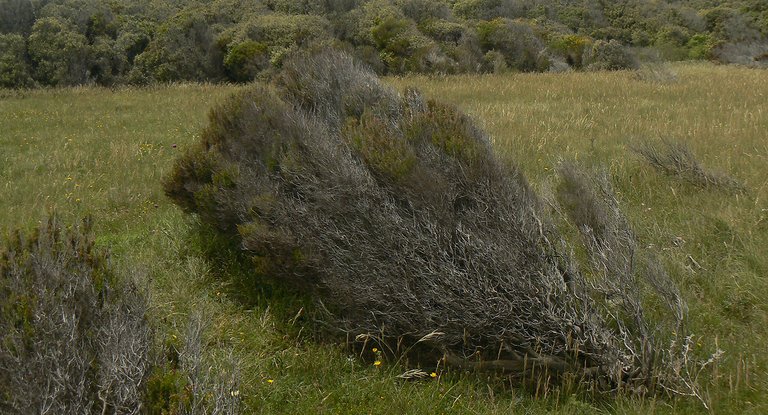
The base of the plant, oriented towards the sea from where the strongest winds are blowing is barren while the opposite, sheltered part of this shrub is prospering.

Like in a cage, among the dry twigs and branches of another tree heather shrub in that area ...
... Urospermum dalechampii flowers were growing. If you enlarge this picture by clicking on it, you'll notice a bee feeding in the center of the flower situated right in the center of the shot. The scientific name of that species from the Halictidae family is Halictus scabiosae.

On one of the twigs above the flowers, I found another interesting moth. This is the Coleophora glaucicolella, a well-camouflaged moth from the Coleophoridae family.
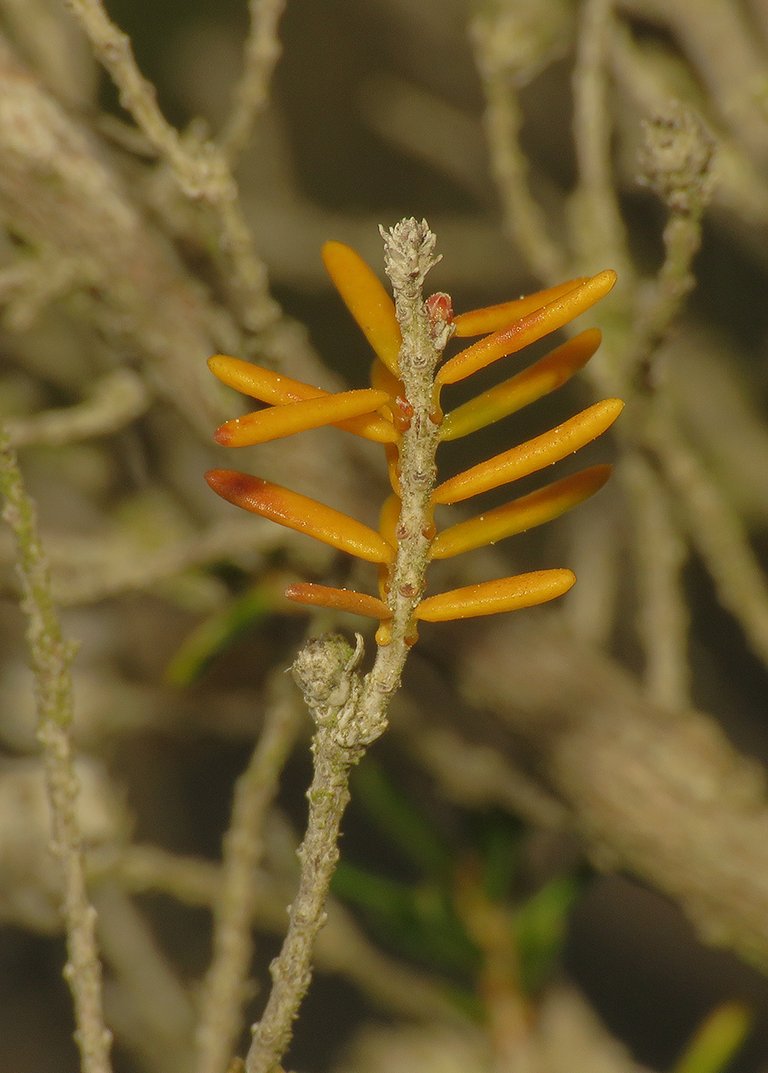
Here you can see a small group of brown leaves that will fall soon.
The dry, barren parts of the shrubs have a certain witchy, gothic appeal when photographed on a gloomy winter day.
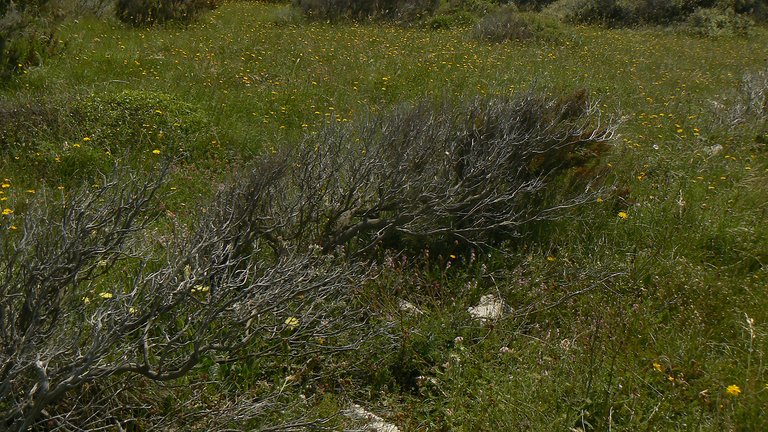
Here you can see a horizontal dry branch surrounded by blooming herbaceous plants in spring.
This set of four photographs taken at the end of March 2021 shows a bunch of fresh Erica arborea flowers.
Here you can see two flies from the Bibionidae family feeding on the flowers.
The name of the species is Bibio marci. The flies shown in the previous picture and the ones in the left and central photograph of this tryptich are males. In the photograph on the right, you can see a female.
Flies from the Bibionidae family are commonly known as March flies.
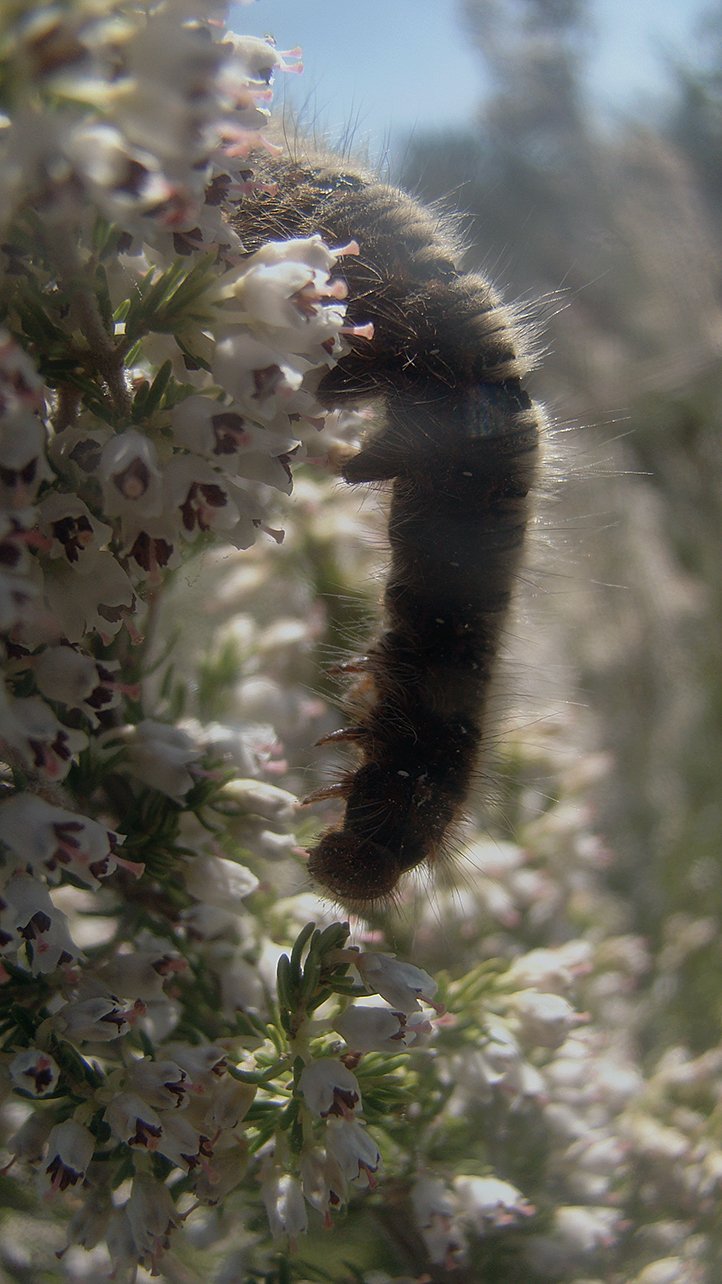
Here you can see a pretty big caterpillar roaming among the flowers. This is the larva of the Lasiocampa quercus, a medium-sized moth from the Lasiocampidae family.
The larva shown in the following photograph is even bigger.
This beautiful, very colorful caterpillar is the larval stage of a large, robust moth from the Sphingidae family. Acherontia atropos is the scientific name of this fairly famous species commonly known as the death's-head hawkmoth.
Here you can see a big, well-camouflaged grasshopper resting on the dead branches of the tree heather shrub that was cut to enlarge the walking path that leads through the dense, intricate maquis.
The name of the species is Anacridium aegyptium. It belongs to the Cyrtacanthacridinae subfamily of the large and varied Acrididae family.

Among the twigs at the top of one of the cut branches, I found a much smaller grasshopper. This is the Chorthippus brunneus, a species from the Gomphocerinae subfamily of the Acrididae family.
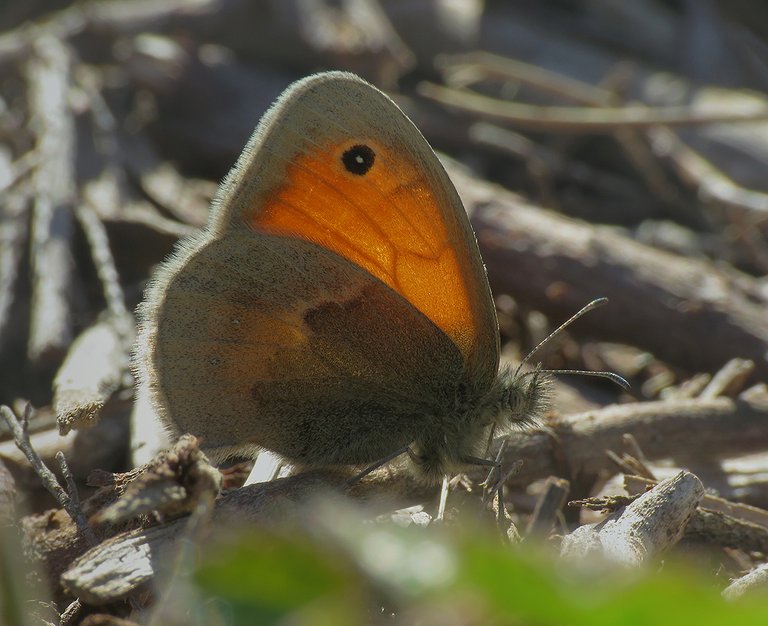
The Coenonympha pamphilus butterfly landed for a minute on the dry twigs and woody fragments scattered on the ground under and around the cut branches.
Coenonympha pamphilus is a small butterfly from the Satyrinae subfamily of the Nymphalidae family.

When the big old shrubs get cut, the young shoots form neat green circles around the stumps.
Here you can see one of those circles from a different angle.
On another one ...
... I found some interesting details when I came closer. Here and in the following triptych...
... you can see a young nymph of the European mantis (Mantis religiosa).
On the top of another twig in the same circle, a tick was waiting for a package of fresh blood in the form of a bird or mammal. A human would be a good source of food as well.
Here you can see a dry, reddish shoot surrounded by many green ones.
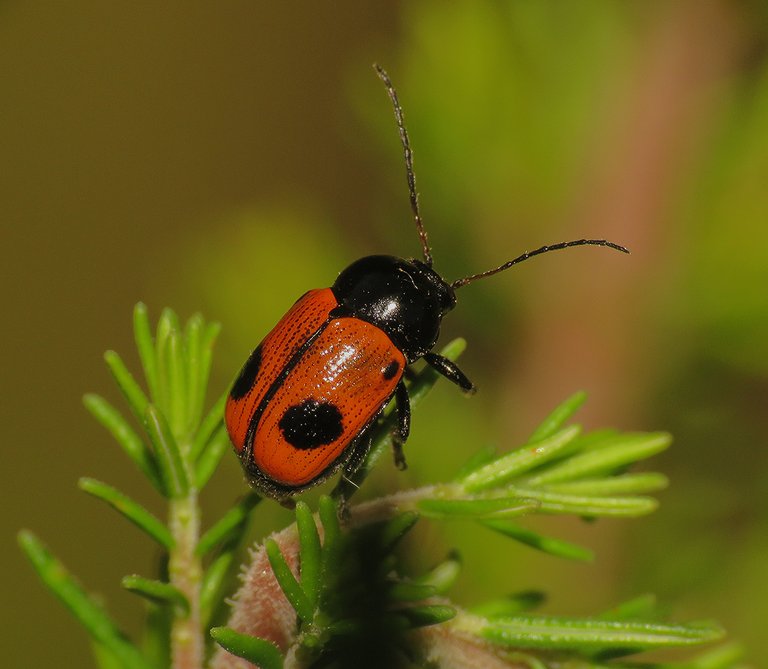
Always in the same circle of shoots, I also photographed this colorful beetle from the Chrysomelidae family.
The name of the species is Cryptocephalus bipunctatus.
On one occasion, while walking through Palera, I saw a relatively big wasp resting on the tree heather.
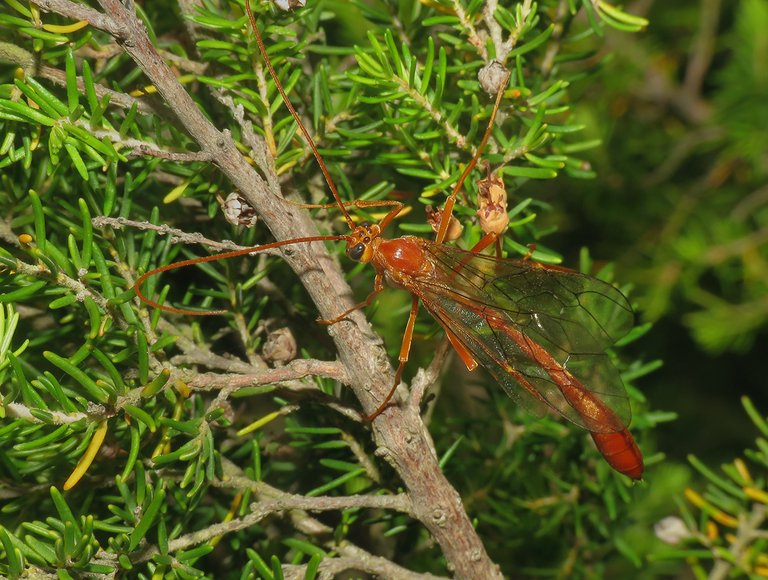
The insect had long legs and very long antennae, and it was a species I hadn't seen before.
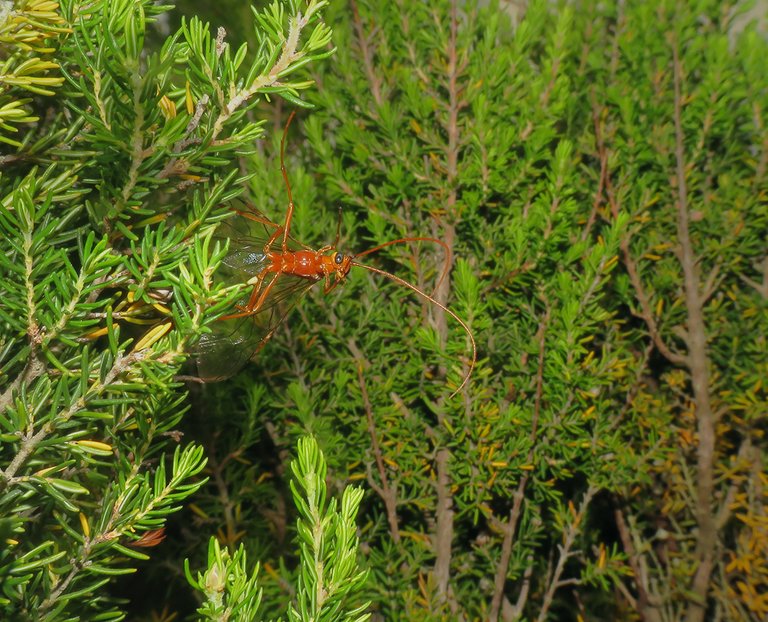
I had to follow the wasp from a distance for a while ...
... before I could get close enough for a good macro shot.
I didn't know the name of the species or anything else about this insect back then in the summer of 2020 when the photographs were taken, but now, I can confidently tell you at least the scientific name of the family, and a bit less confidently - the name of the genus.
Dear friends and others, this is an Ichneumon wasp, which means that the species belongs to the Ichneumonidae family. The genus is probably Ophion.
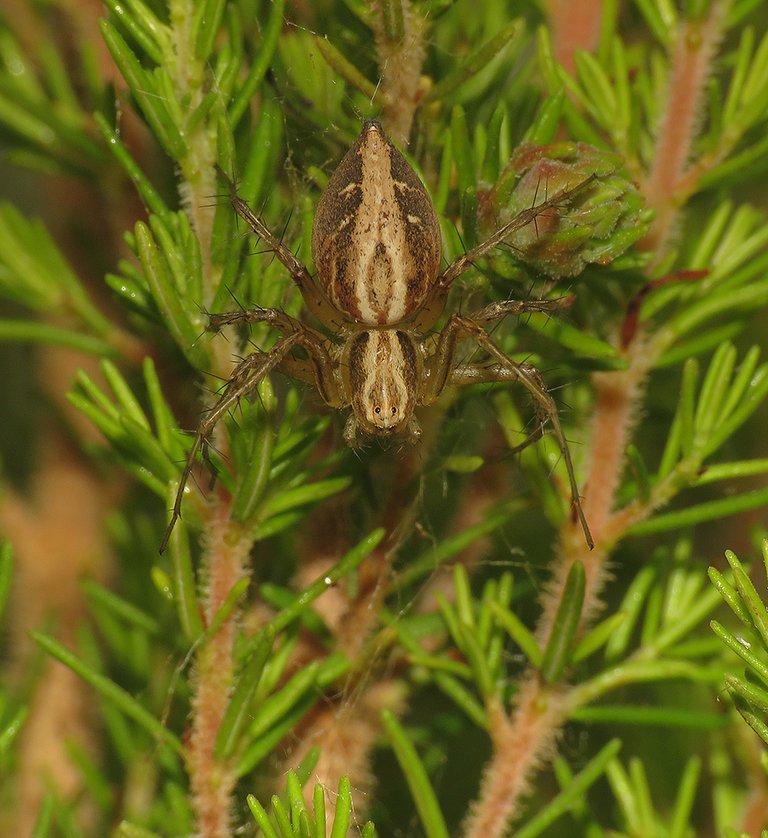
Here you can see a spider waiting in ambush on the twigs near the top of the shrub.
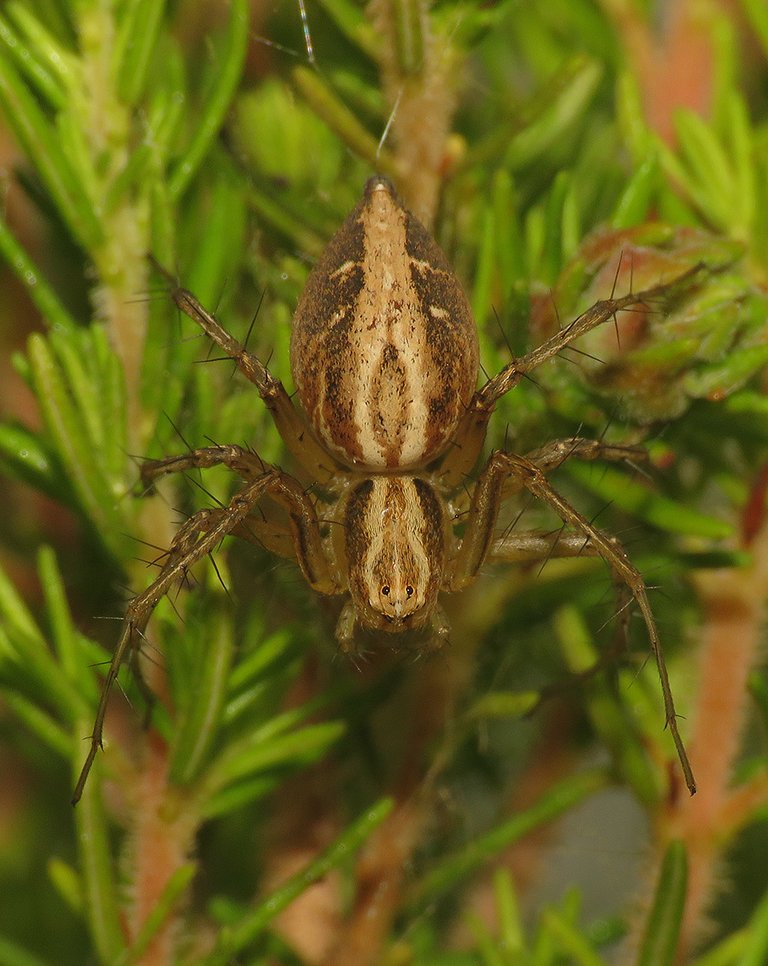
This is the Oxyopes heterophthalmus, a spider from the Oxyopidae family.
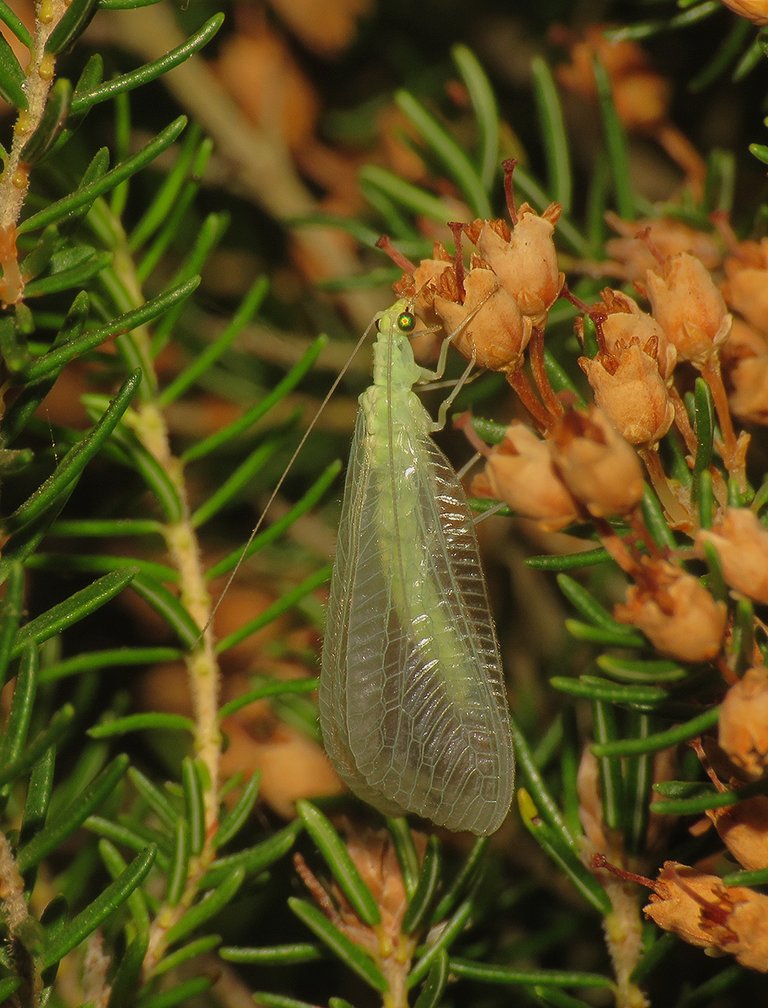
In July 2021, I found a fresh new green lacewing that recently came out of its larval skin.

The insect was posing among the tiny brown fruits of a large tree heather shrub.
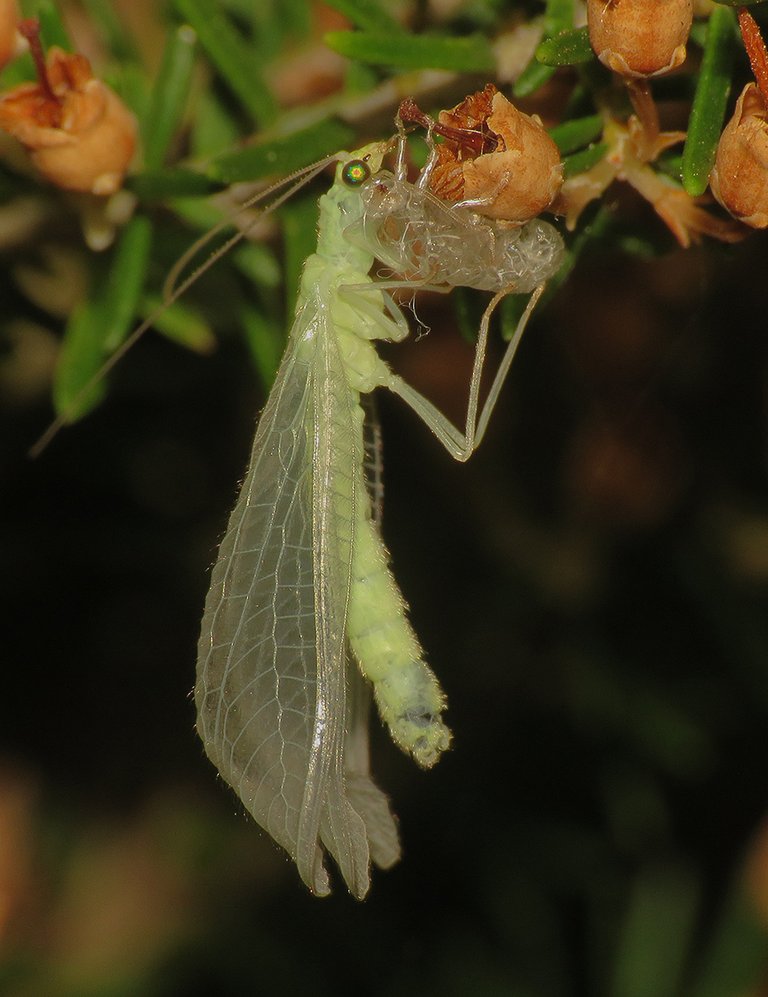
If you take a good look at the details of this shot, you'll notice the translucent empty exoskeleton near the head of the green lacewing.

The scientific name of the species is Chrysoperla carnea.
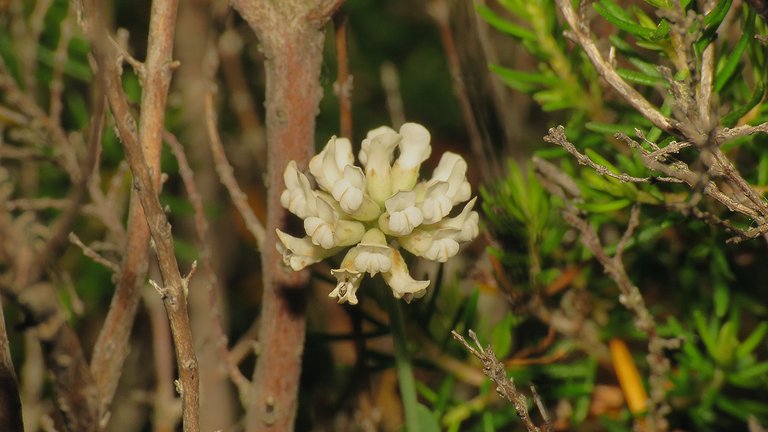
Near the ground, among the lowest twigs and branches of the shrub, I found and photographed a cluster of Lotus herbaceus flowers.

On the top of another shrub, I had the opportunity to photograph a predatory fly with its prey. In this and the following photograph ...

... you can see the Dioctria longicornis, a fly from the Asilidae family, feeding on a much smaller fly from the Sciaridae family.
Among the branches a bit lower on the same shrub, I took this portrait of an Acrida ungarica grasshopper.

Here you can see a Neoscona adianta spider resting on the lower twigs of the nearby shrub. Neoscona adianta is an orb-weaving spider from the Araneidae family.
This set of four photographs shows a Philoscia muscorum woodlouse on one of the relatively thick branches at the base of the shrub.
When the following shot was taken ...
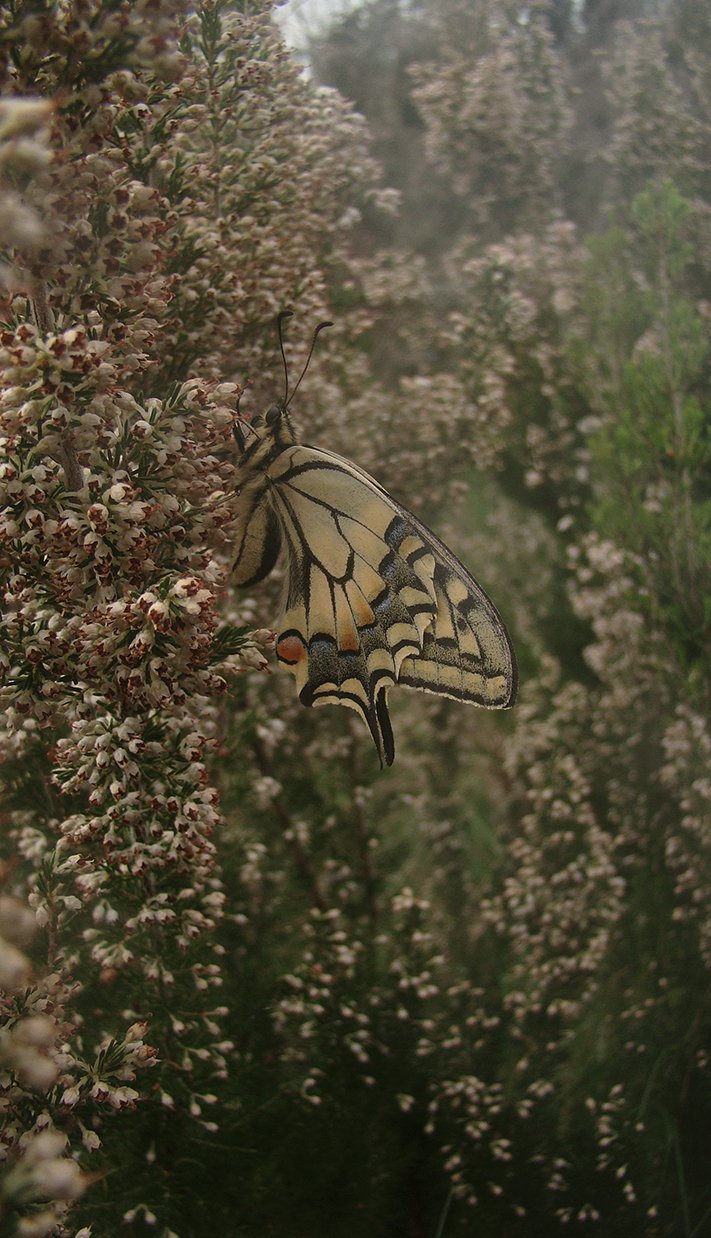
... the tree heathers were fully in bloom, and Papilio machaon, a big butterfly from the Papilionidae family was resting on one of the shrubs with its wings folded.
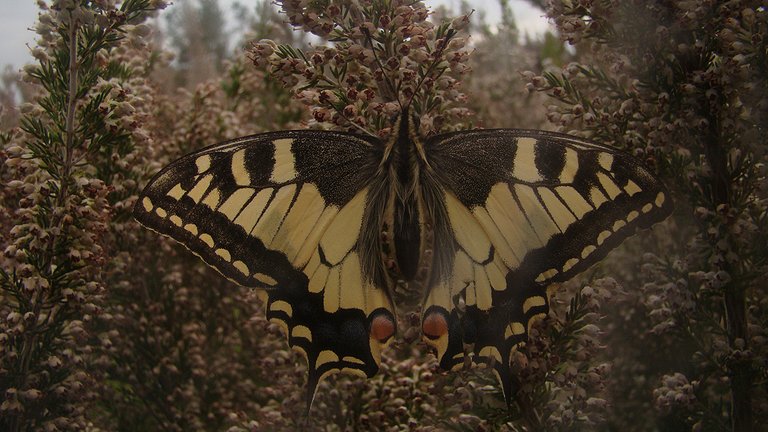
When I got closer ...
... the beautiful butterfly spread its wings.

Here you can see a flower of the Leontodon hispidus plant that was growing surrounded by shrubs.
The same day I also photographed this interesting larva on one of the lover branches of a tree heather shrub.
I can't tell you what species exactly this is but I'm sure that it belongs to the Psychidae family.
In their larval stage, moths from that family use straws, twigs, and other materials to build protective shells. Each species has a different architectural style.
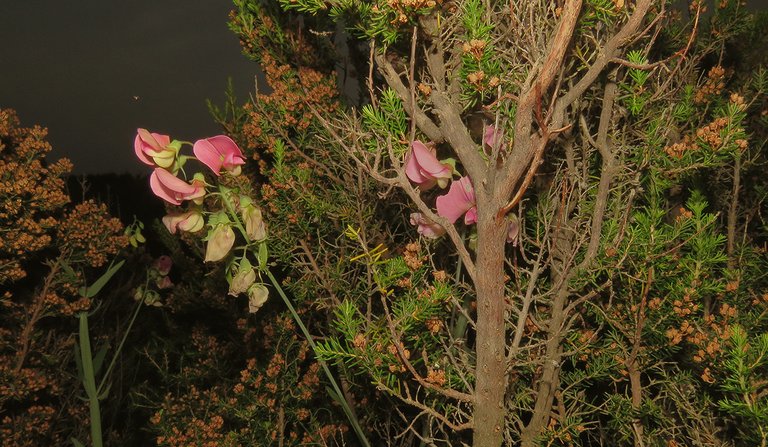
Here you can see the flowers of the Lathyrus latifolius plant ...

... that was growing as a vine entangled with the branches of the Erica arborea shrub. The photograph was taken in the summer of 2022.
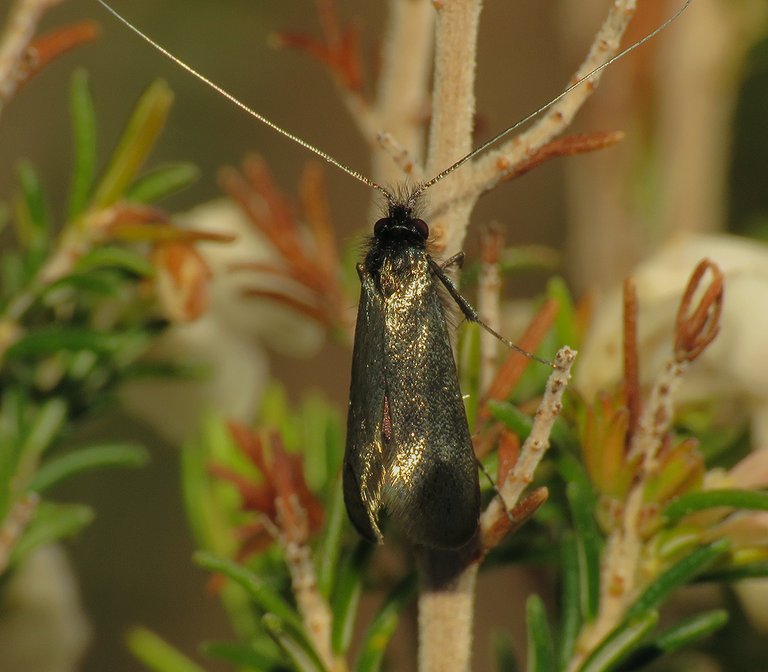
This is the Adela reaumurella ...
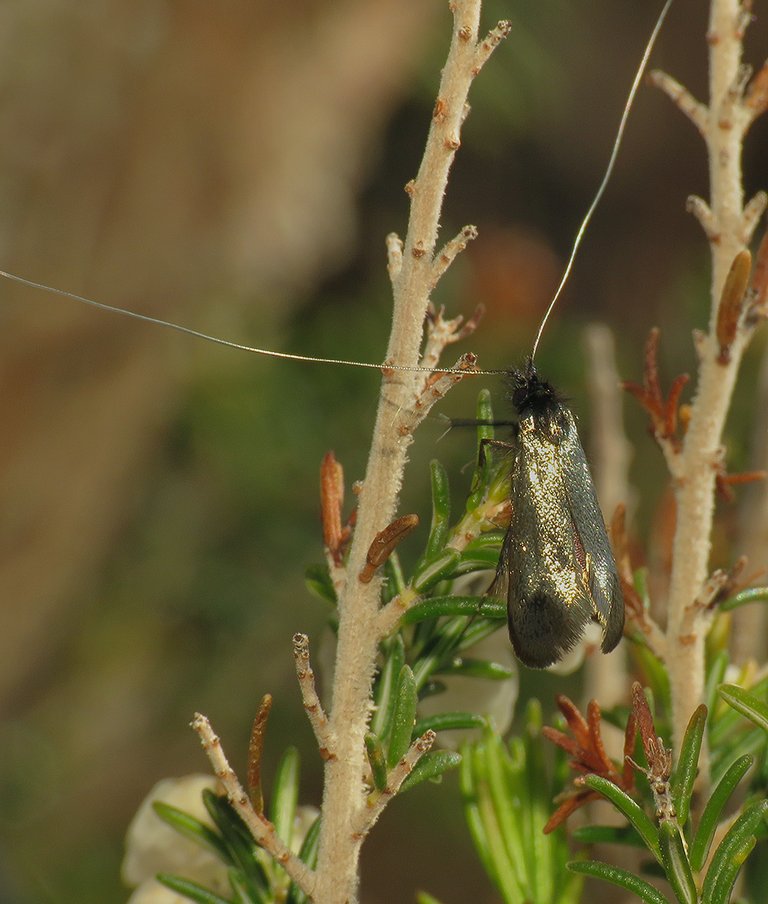
... a moth from the Adelidae family.

Its antennae are extremely long and its wings are iridescent. It's a very cool moth.

I decided to end this post with a photograph taken on the 23rd of April 2021, at the end of a long sunny day.
As the night was approaching, a Bombus terrestris bumble bee found a nice sleeping place on the tree heather shrub.
AND THAT'S IT. I HAVE NOTHING ELSE TO SAY. NO MORE PICTURES TO SHOW TODAY. AS ALWAYS HERE ON HIVE, THE PHOTOGRAPHS ARE MY WORK.
The following links will take you to the sites with more information about some of the protagonists of today's post. I found some stuff about them there.
https://en.wikipedia.org/wiki/Cidnopus_pilosus
https://en.wikipedia.org/wiki/Colletes_succinctus
https://en.wikipedia.org/wiki/Erica_arborea
https://en.wikipedia.org/wiki/Melanargia_galathea
https://en.wikipedia.org/wiki/Large_tortoiseshell
https://en.wikipedia.org/wiki/Bacillus_rossius
https://en.wikipedia.org/wiki/Colletidae
https://en.wikipedia.org/wiki/Andrenidae
https://en.wikipedia.org/wiki/Tettigonia_viridissima
https://en.wikipedia.org/wiki/Nine-spotted_moth
https://lepidoptera.eu/species/5279
https://en.wikipedia.org/wiki/Agriphila_inquinatella
https://en.wikipedia.org/wiki/Halictus_scabiosae
https://en.wikipedia.org/wiki/Urospermum_dalechampii
https://en.wikipedia.org/wiki/Coleophora_glaucicolella
https://en.wikipedia.org/wiki/Bibio_marci
https://en.wikipedia.org/wiki/Lasiocampa_quercus
https://en.wikipedia.org/wiki/Acherontia_atropos
https://en.wikipedia.org/wiki/Anacridium_aegyptium
https://en.wikipedia.org/wiki/Chorthippus_brunneus
https://en.wikipedia.org/wiki/Small_heath_(butterfly)
https://en.wikipedia.org/wiki/European_mantis
https://www.coleoptera.org.uk/species/cryptocephalus-bipunctatus
https://en.wikipedia.org/wiki/Ophion_(insect)
https://en.wikipedia.org/wiki/Oxyopes_heterophthalmus
https://en.wikipedia.org/wiki/Chrysoperla_carnea
https://en.wikipedia.org/wiki/Lotus_herbaceus
https://www.robberflies.info/keyger/htmle/diolon.html
https://en.wikipedia.org/wiki/Acrida_ungarica
https://en.wikipedia.org/wiki/Neoscona_adianta
https://en.wikipedia.org/wiki/Philoscia_muscorum
https://en.wikipedia.org/wiki/Papilio_machaon
https://en.wikipedia.org/wiki/Leontodon_hispidus
https://en.wikipedia.org/wiki/Bagworm_moth
https://en.wikipedia.org/wiki/Lathyrus_latifolius
https://en.wikipedia.org/wiki/Green_longhorn
https://en.wikipedia.org/wiki/Bombus_terrestris
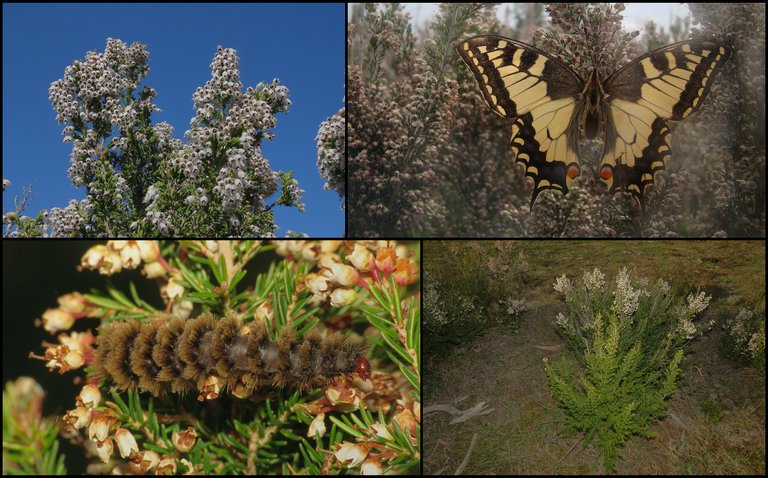


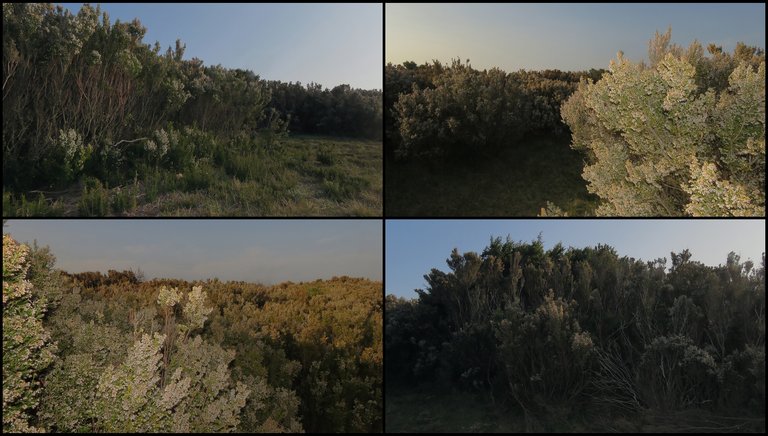
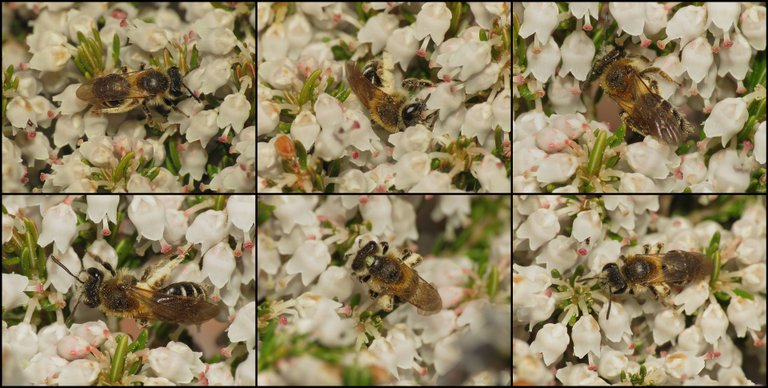
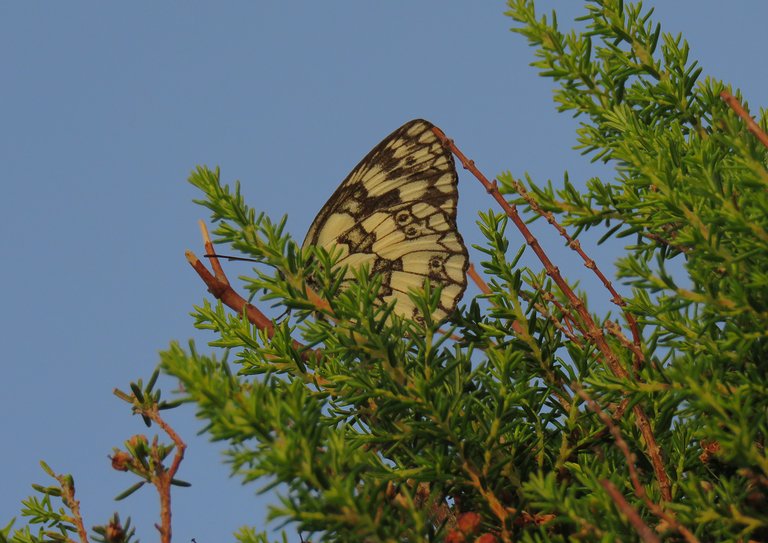
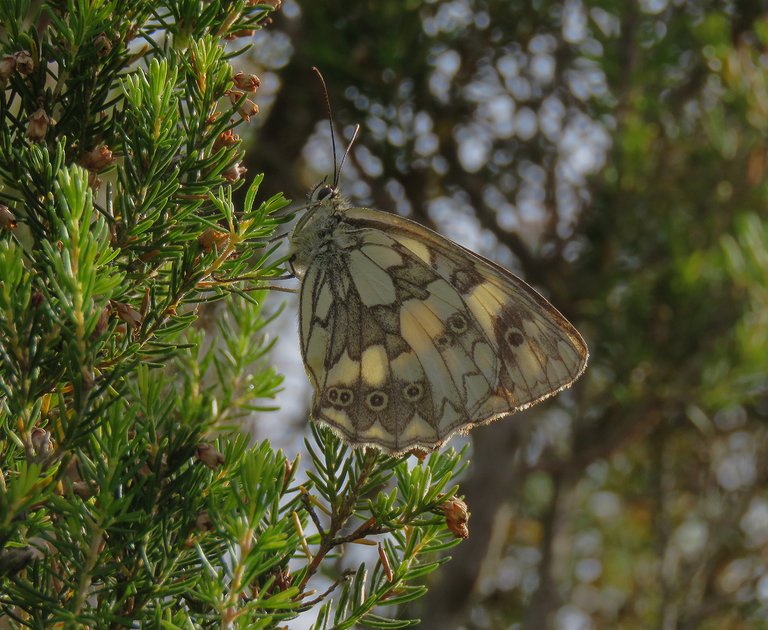
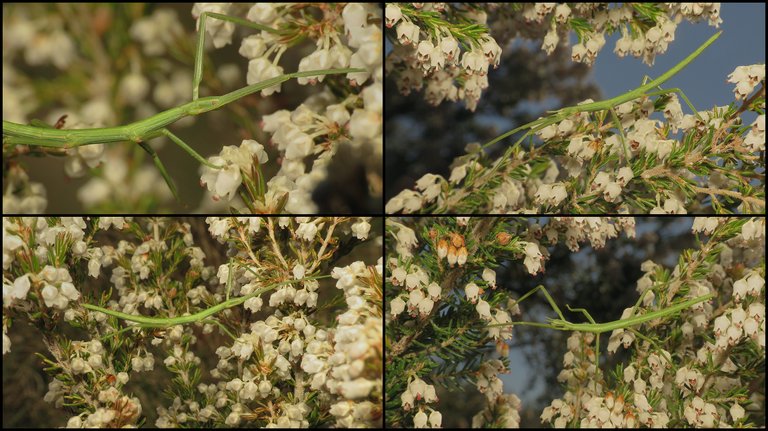

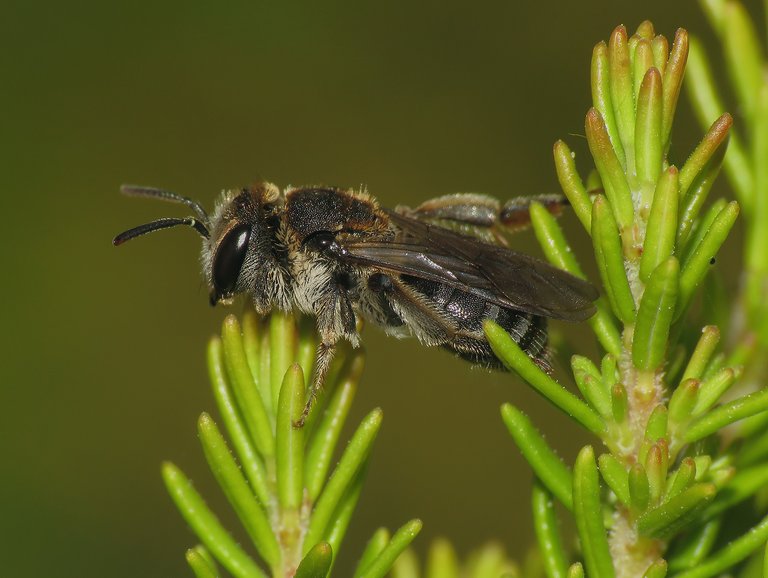




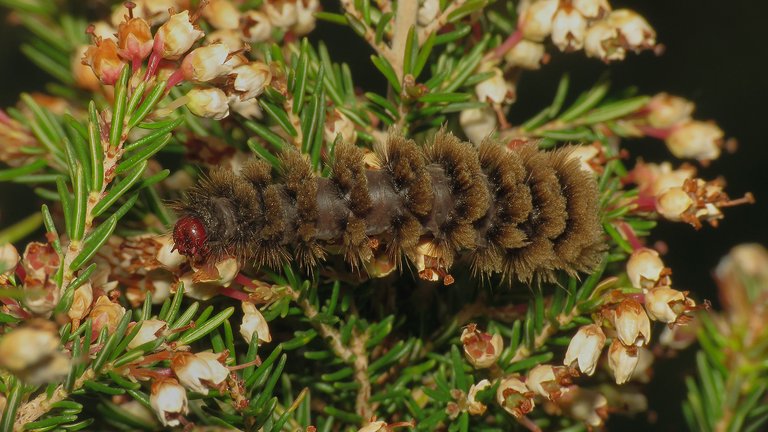
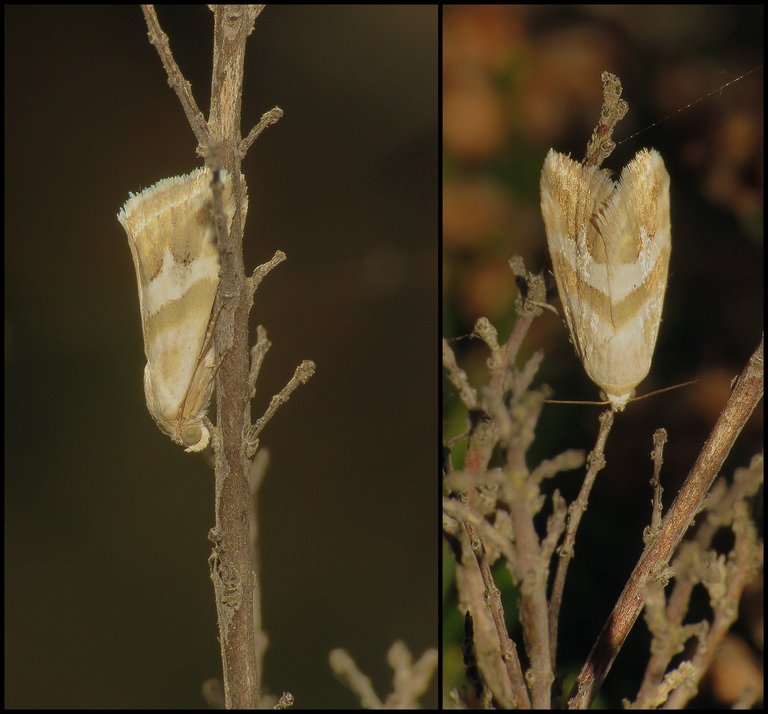

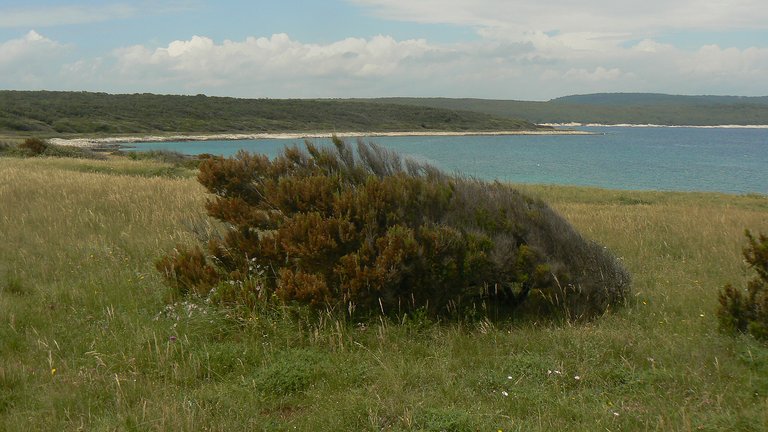
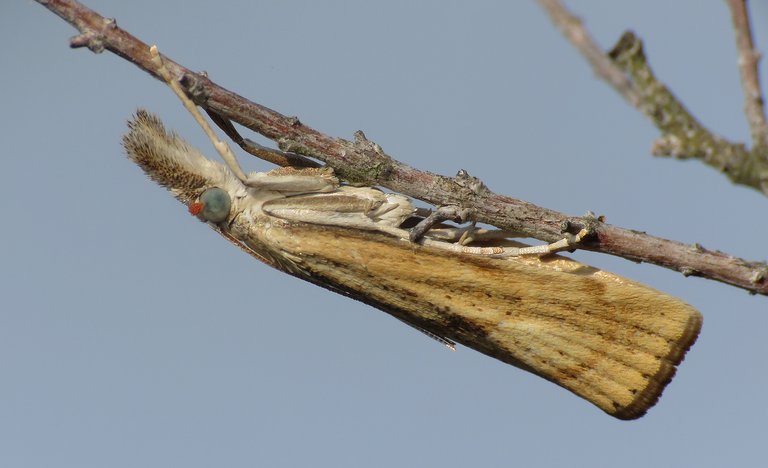





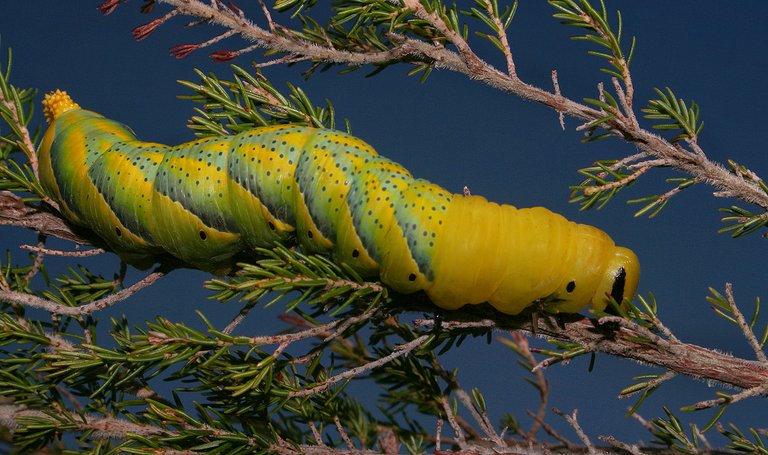
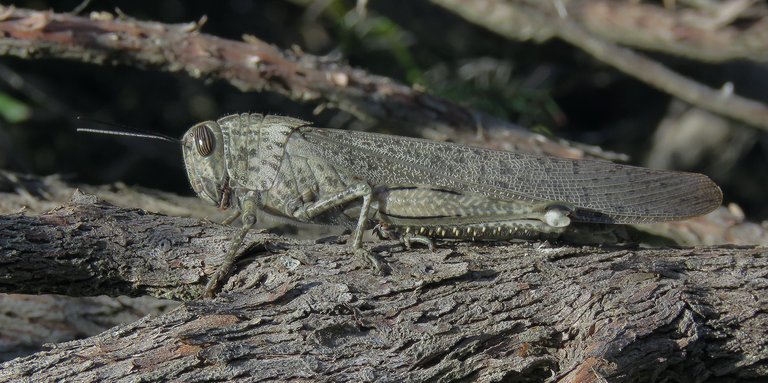
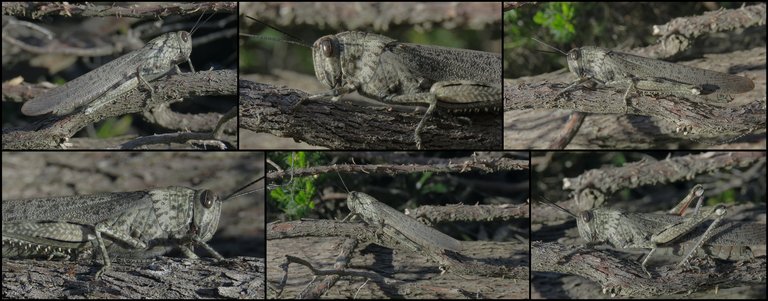

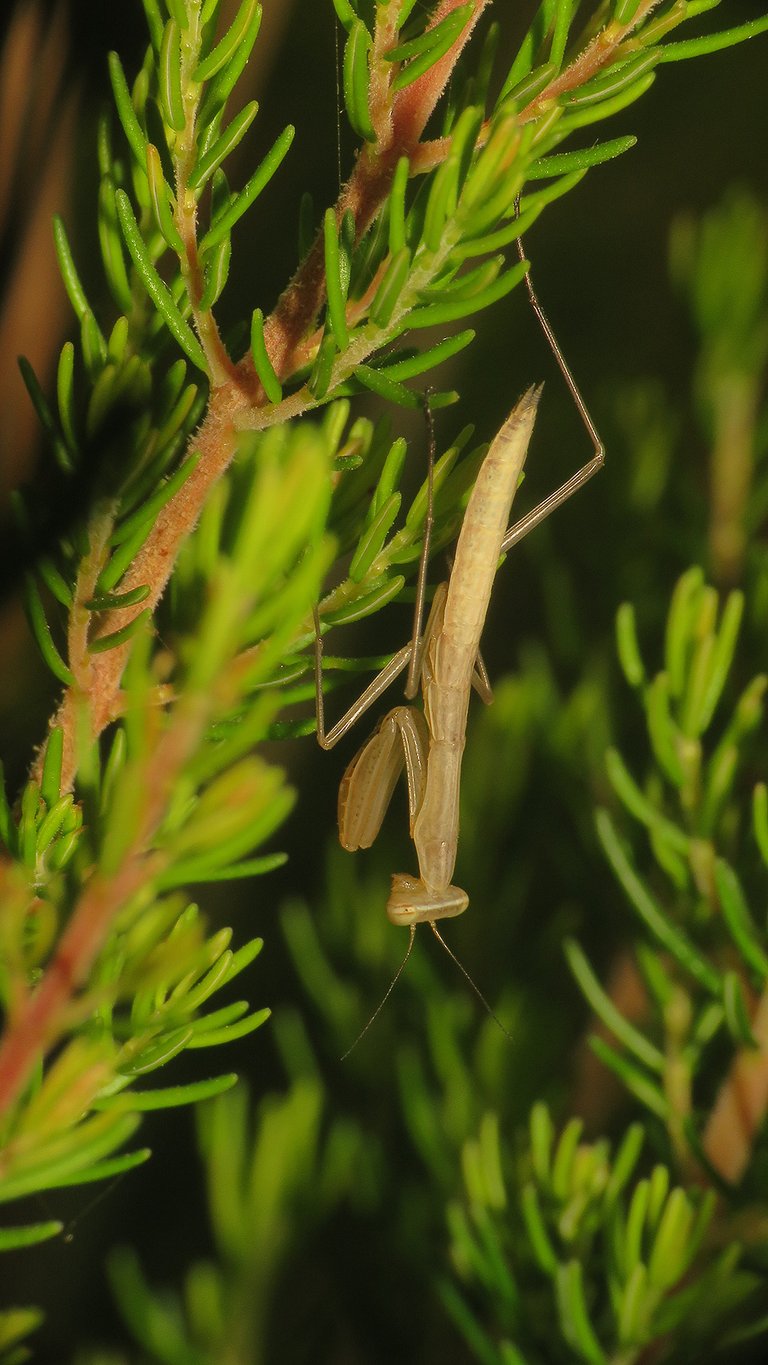

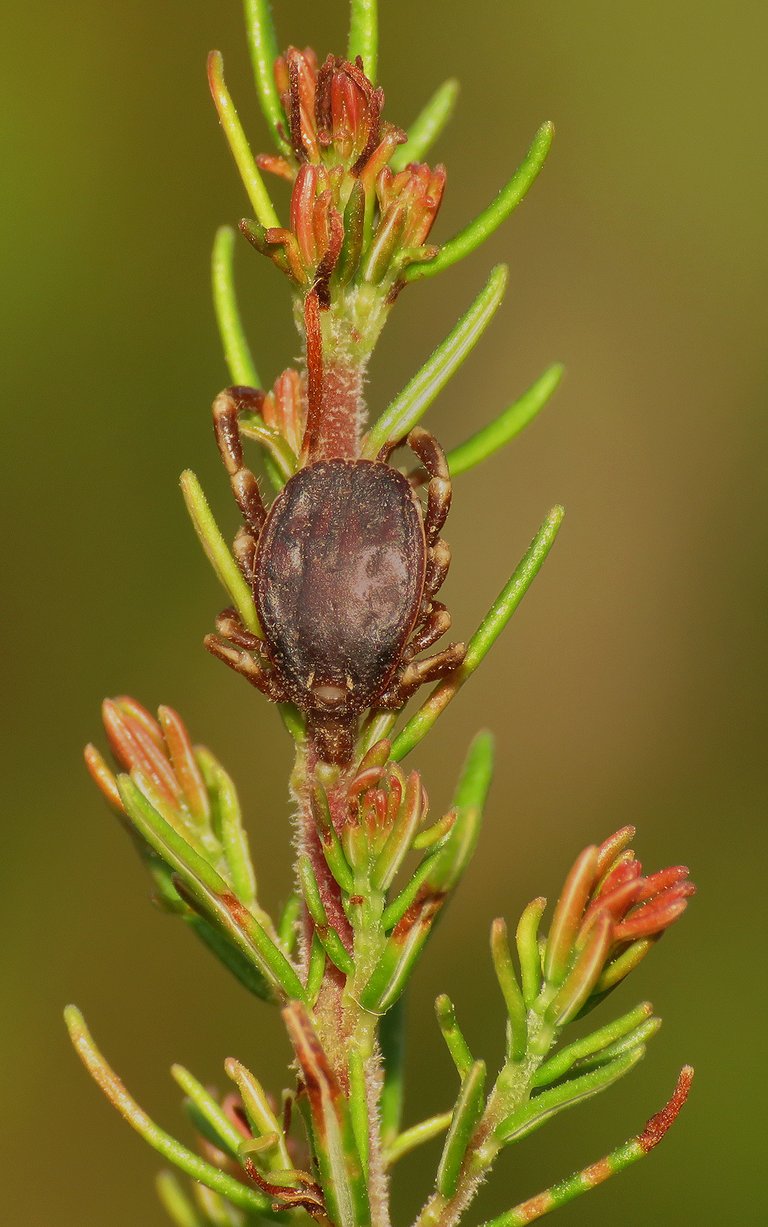
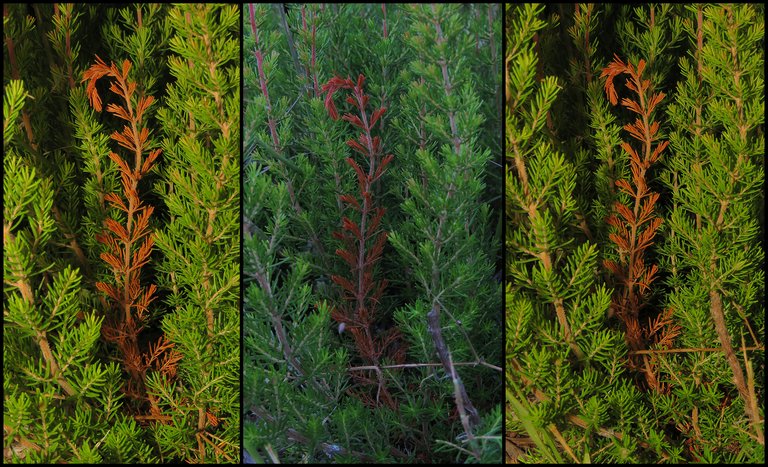


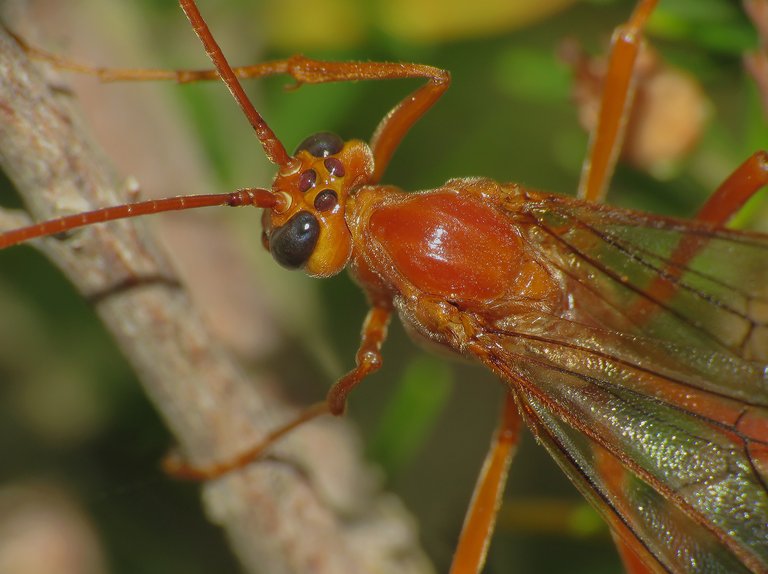
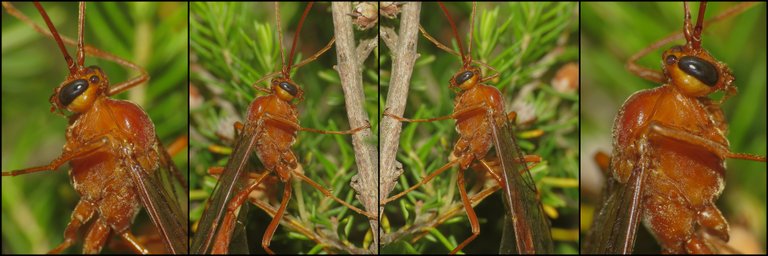

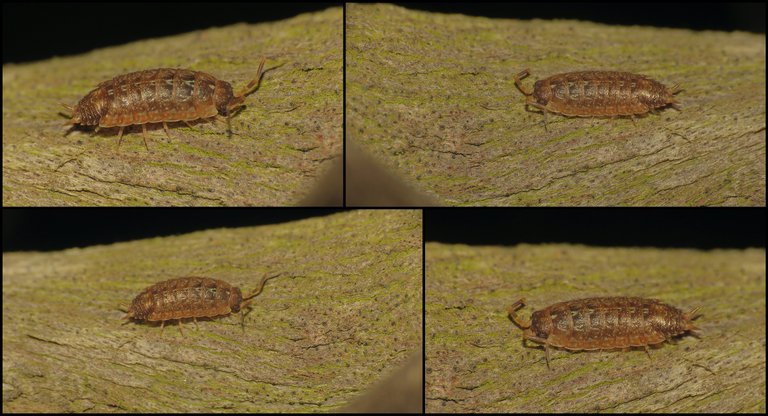
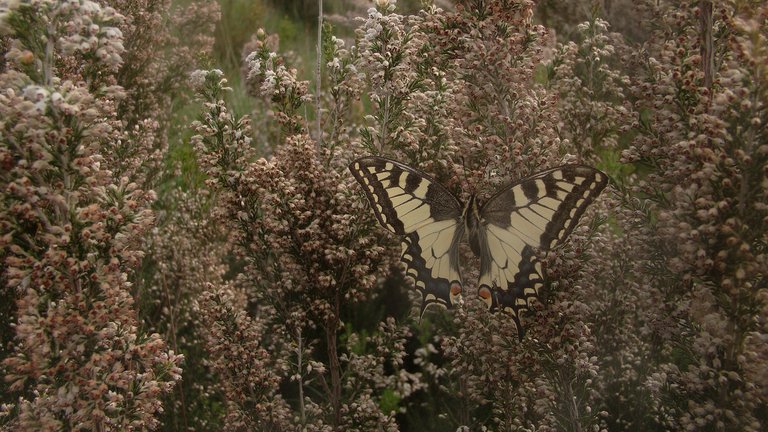
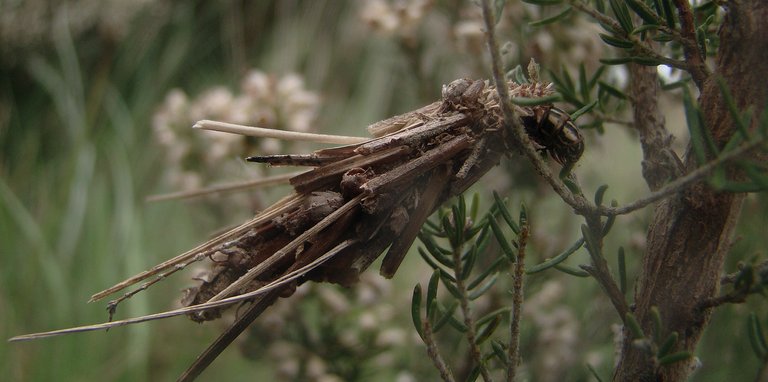
Excellent work, I do love macrophotography and realise just how many bugs etc I've never seen or heard of before, it's a great past time to at least pass a morning on in the garden and admire just what is out there in the macro world.
Yes, exploring the small animals and details of plants through the macro lens is fun. There are many interesting species out there, and you never know what situation or behavior you'll witness while watching nature so up close.
Congratulations, your post has been added to Pinmapple! 🎉🥳🍍
Did you know you have your own profile map?
And every post has their own map too!
Want to have your post on the map too?
Wow! those are some photos. I find it difficult to take a good photo of a butterfly. Compare to that you've managed to capture all butterflies, bees & all other insects.
Truly amazing.
@sagarkothari88 vote 17.5%
Yes, butterflies often aren't easy to catch with the camera. 🙂 Sometimes, fortunately, they are sleepy and quiet. Early in the morning and the evening I usually get good opportunities.
In the middle of the day, when they are very active, I never chase them. I just sit down near their favorite flowers and wait. After some time has passed, they get costumed to my quiet presence and I can photograph them.
Butterflies are so beautiful, always a very welcome sight in my garden throughout Summertime !VSC
Have a great day Borjan & stay !ALIVE 👌
@fun.farms has sent VSC to @borjan
This post was rewarded with 0.1 VSC to support your work.
Join our photography communityVisual Shots
Check here to view or trade VSC Tokens
Be part of our Curation Trail
@fun.farms ha enviado VSC a @borjan
Éste post fue recompensado con 0.1 VSC para apoyar tu trabajo.
Únete a nuestra comunidad de fotografía Visual Shots
Consulte aquí para ver o intercambiar VSC Tokens
Se parte de nuestro Trail de Curación
@borjan! You Are Alive so I just staked 0.1 $ALIVE to your account on behalf of @ fun.farms. (1/10)
The tip has been paid for by the We Are Alive Tribe through the earnings on @alive.chat, feel free to swing by our daily chat any time you want, plus you can win Hive Power (2x 50 HP) and Alive Power (2x 500 AP) delegations (4 weeks), and Ecency Points (4x 50 EP), in our chat every day.

From dawn to dusk You have shown naturally beauty , great And stunning photos. Really admire your work. Bell shaped flowers are very beautiful. You have shown a great aspect of life.
These pictures are so nice
I love how you captured each of them. You’re so perfect. My favorite shot is that of the butterfly
Thank you. 🙂 Glad you like these posts about nature.
https://twitter.com/lee19389/status/1750952539481145725
#hive #posh
The pictures of the bee my favorite plus the information about the trees is very interesting.
How are you dear friend @borjan good afternoon
What an interesting post, and how much information, as well as beautiful photographs, you show us this opportunity. The diversity of insects there is impressive.
I take this opportunity to wish you a splendid afternoon
Great photography article!
Love the detailed insects pictures in particular! :D
https://twitter.com/LovingGirlHive/status/1750991428921278797
Wow! This is amazing, nature is truly beautiful.
Great shots friend😃
Thanks. 🙂 Glad you like this post infested with insects.
You are welcome😃
great post proving the central role of trees in an ecosystem. they are truly pillars of diversity and you have captured this so well
Thank you. 🙂 Glad you like this story about nature in my area.
The pictures you show are extraordinary,I was amazed to see this picture of yours.
Thanks. 🙂
It's great to see you sharing your knowledge about the tree heather and its unique biodiversity. Your posts always makes me learn about the intricate relationships between different species in our ecosystems like this one.
The Cidnopus pilosus beetle climbing the twigs on the shru although tin looks like a hardworking worker bee.
It's amazing how the Colletes succinctus bee feeds on the nectar of the tree heather flowers.
I really loved the Melanargia galathea butterflies, I am must say, they are really a beautiful sight to behold.
All of the shots you shared are beautiful too 😍
Yay! 🤗
Your content has been boosted with Ecency Points, by @borjan.
Use Ecency daily to boost your growth on platform!
Incredible compilation of pure nature!!
Post manually reviewed. 😊
Thank you. 😃 Glad you like this post infested with insects.
When the sun comes out like this in the winter it's a day to wander and it's so nice to see all these pictures you've done so well. Photographing butterflies is not easy at all as they start flying after a while.
I truly Impressed on how you were able to get this beautiful biodiversity of this habitat, well taken pictures and beautiful species of this insects. Till date I am still scared of caterpillar 😔🙈🫣.
That's really a beautiful photography work done over here
Awwww... Lots of amazing creatures masterfully photographed!
!discovery 40
!VSC
!PIZZA
!BBH
@jlinaresp has sent VSC to @borjan
This post was rewarded with 0.1 VSC to support your work.
Join our photography communityVisual Shots
Check here to view or trade VSC Tokens
Be part of our Curation Trail
@jlinaresp ha enviado VSC a @borjan
Éste post fue recompensado con 0.1 VSC para apoyar tu trabajo.
Únete a nuestra comunidad de fotografía Visual Shots
Consulte aquí para ver o intercambiar VSC Tokens
Se parte de nuestro Trail de Curación
@borjan! Your Content Is Awesome so I just sent 1 $BBH (Bitcoin Backed Hive) to your account on behalf of @jlinaresp. (5/5)
This post was shared and voted inside the discord by the curators team of discovery-it
Join our Community and follow our Curation Trail
Discovery-it is also a Witness, vote for us here
Delegate to us for passive income. Check our 80% fee-back Program
https://reddit.com/r/blogs/comments/1acdtub/the_tree_heather_post_macro_photography_hive/
The rewards earned on this comment will go directly to the people( @jlinaresp ) sharing the post on Reddit as long as they are registered with @poshtoken. Sign up at https://hiveposh.com.
Amazing photographs 😍
Have a great day 😊
Very cool summer photos, and it makes me feel lot warm when I see them. That very Big Butterfly which opens its wings when you went close... here in my summer forest I see it very rarely, so for me it is rare .😅👌👌☕🦊
Thank you. 😃 Glad you like the post.
Those swallowtail butterflies were widespread and numerous here where I live, but in the last few decades, they have become pretty rare.
!BEER
Looks so beautiful, and there are lot of insects landing on it.
Your photography skills is second to none. Thanks for always sharing this wonderful post
Absolutely fabulous insects, you think you've seen it all! Rice Paper Wings, Fur Coated Caterpillars!
Fantastic!
Nice shots
Good gray five, it looks great as a spring post and colorful with frames ;))